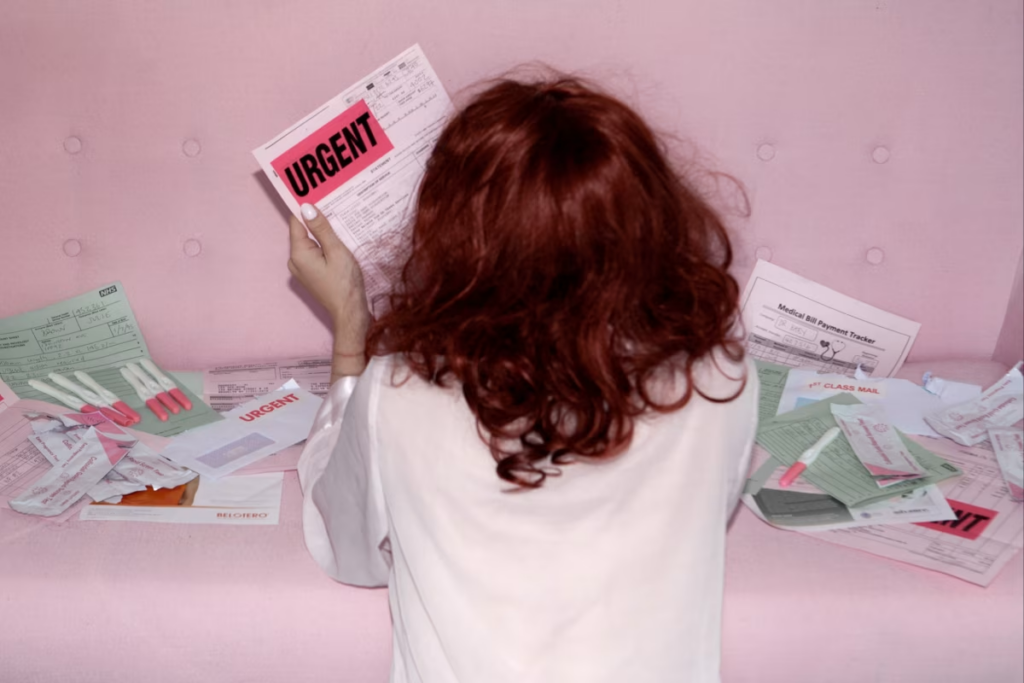The thrum of rushing passengers reverberated beyond the door of a bathroom cubicle in a distant corner of Oslo airport. Crouched low over half a dozen bottles of white powder, I groped in the gloom for a needle and syringe. Drawing up a thimbleful of distilled water, I plunged the fluid into each bottle in turn. The mixture whitened and then became clear. I flicked out a last air bubble, lifted up my T-shirt and pushed the needle into my lower abdomen.
“Dette er siste opprop for passasjerer som skal til London Heathrow,” rang the tannoy overhead. The nightly ritual, which usually takes place in the less squalid venue of my flat in London, always brings to mind Trainspotting or Breaking Bad, with its vague feeling of the illicit and its Walter White-ish choreography of vials and chemicals.
But during the past year it has become a more mundane staple of my routine, one whose rigid schedule must be accommodated around working days, social plans — and, in this case, holidays. I am one of a rapidly growing number of people taking advantage of a leap in the science of fertility that has allowed them to artificially turbocharge their production of eggs.
At the end of a month-long “round” of daily growth-stimulating medication, the tiny cells are then extracted and frozen for possible fertilisation at a later date. A complicated and startlingly expensive process, which can be repeated over as many months as are required to harvest a desired number of eggs, egg-freezing has undergone both a technical and commercial transformation during the past decade that has dramatically improved its success rates, helping to propel it into the mainstream.
According to the Human Fertilisation and Embryology Authority, the number of patients freezing their eggs each year in the UK more than tripled between 2015 and 2021 to 3,315. In the US, data from the Centers for Disease Control and Prevention shows that the number of fertility preservation cycles per year increased by 25 per cent between 2019 and 2021 to 413,776.
Yet while egg-freezing dangles the possibility of a societal breakthrough, allowing women — and those born female but adopting other gender identities — to free themselves of the spectre of the “biological clock”, it is littered with practical and ethical pitfalls. For most, the process is prohibitively expensive, often running to tens of thousands of pounds, while the results are a lottery. Not only is there no guarantee of how many eggs will be collected each month, but many are later lost in the unwieldy processes of thawing, fertilisation and embryo development.
Funding for the procedure has become a bargaining chip in corporate talent wars, particularly in high-paying sectors such as tech and financial services, raising questions over the ethics of incentivising employees to extend their childless working lives. Meanwhile, some experts argue that the fertility industry capitalises on growing paranoia among women who are waiting longer to start families, despite the fact that many still conceive naturally well into middle age.
“You’ve only got to look at the websites of all the major IVF units to see that there is an enormous sell on to say: do you want to protect your fertility?” says Ingrid Granne, deputy head of the Nuffield Department of Women’s & Reproductive Health at the University of Oxford. However, she adds, “If I look at my own daughter, would I be quite keen if [egg-freezing] were an option for her? Probably I would, actually.”
When I decided in early 2023 to begin freezing my eggs at the age of 33, I had a relatively unusual reason for doing so. As well as being single and fretting about my dwindling egg reserves, I had also begun to identify as non-binary, and felt increasingly that carrying a child myself would spark uncomfortable feelings of gender dysphoria. A few months before I started egg-freezing, I got in touch with a female friend of a similar age who’d recently finished the process.
She told me she’d had a relatively straightforward experience, collecting a total of 24 eggs from two rounds — an average result for someone in their mid-thirties. But she warned me it had been gruelling. “I’ve never been so tired in my life,” she said of the effect of the daily hormone injections that are used to stimulate egg growth. “I could feel it behind my eyes.” So it was with some trepidation that I made my way one sunny April lunch break to a Boots chemist in central London, just around the corner from the FT offices, to collect the drugs that would be required for my first cycle. I approached the counter and told the cashier my name.
“Oh, India. Yes,” she said, looking slightly concerned for me. “This is quite the order.” I wasn’t sure what she meant, until a colleague reached into the recesses of the prescription storage area and pulled out a rucksack-sized bag of medication. “That’ll be £1,893.02,” the cashier said. A few weeks later, I sat on a Zoom call with a nurse from the Centre for Reproductive & Genetic Health on London’s Great Portland Street, a private clinic I’d chosen based on my friend’s recommendation and some promising-looking statistics on its website.

“So you’ll be doing one injection in the morning, and one or two in the evening, OK?” the nurse said patiently, wielding a demonstration syringe and gesturing to a piece of paper that laid out my complex drug regimen for the coming weeks. As it happened, integrating this daunting injection schedule into my daily life proved surprisingly straightforward, as friends and family became accustomed to my surreptitious trips to the bathroom with a bulging bag of syringes.
More problematic was the impact of raging hormones on what was already an emotional rollercoaster. One afternoon, a few days before my first egg collection was scheduled, my consultant called to tell me that my scans showed the medication was not working as well as she’d hoped. At best, she said, they would be able to collect three eggs. I slumped into a leather chair in the cavernous foyer of the office.
According to the clinic’s statistics, for my age group, 20 eggs would give an 85 per cent chance of one live birth. Three was nowhere near that. “I think we should just give it a go,” she said kindly, jettisoning the alternative of abandoning the round and forfeiting the sunk cost of the drugs. “Hopefully the next cycle will be better.” As I hung up the call, colleagues streamed past me through the glass doors into the sunset on their way home for the day. I hid my face in my hands.
The first successful pregnancy from a frozen egg cell was achieved in Australia in 1986, eight years after the first “test tube baby”, Louise Brown, was born via in vitro fertilisation — a process that usually involves the immediate fertilisation of extracted eggs, without the need for freezing. Marking the feat, the medical journal The Lancet noted that 80 per cent of the mother’s egg cells had survived being plunged to -196C, stored in liquid nitrogen, and then thawed in a warm water bath.
“A twin pregnancy was achieved after insemination and replacement in utero,” the medical journal declared. In the decades since, advances in the speed of cryogenic freezing, as well as increased public awareness of fertility treatments, has led to a surge in demand, particularly as heterosexual women — who make up the majority of egg-freezers — remain single for longer and begin family planning later in life. According to the Office for National Statistics, the average age at which women give birth in England and Wales rose to 30.9 years in 2021, from a postwar low of 26.4 in 1975.
HFEA data shows that in 2020-21 the average age of people freezing their eggs was 35. “There’s been a normalisation process,” says Marcia Inhorn, a professor of anthropology and international affairs at Yale University and author of Motherhood on Ice: The Mating Gap and Why Women Freeze Their Eggs. “I think the most educated women in America have heard of egg-freezing.” Inhorn, who studied more than 100 women who chose to freeze their eggs for non-medical reasons, found that — contrary to the belief of some feminist scholars — the decision to do so was usually not driven by a desire to focus on their careers.
Instead, she says, straight women are finding it increasingly difficult to find suitable partners, owing to “massive discrepancies” in educational attainment between men and women in the US. But if egg-freezing seemingly offers a possible solution to this demographic problem, it does so only for the lucky few. “I don’t think it’s ever going to be a revolution like the [contraceptive] pill because it is so exclusionary,” Inhorn says. “It’s way too expensive.” Critics argue that the industry also exploits an information gap, in which consumers who are not well versed in the science of fertility are convinced to part with their savings based on success rate data that can be incomplete or misleading.
“What clinics shouldn’t be doing is creating unnecessary anxiety about what happens if you don’t freeze your eggs and . . . unnecessary expectations about the possibilities or the likelihood of success if you do,” says Catherine Hill, head of policy and public affairs at the charity Fertility Network UK. “We are deeply concerned that the level of information clinics are providing on their websites could lead to this happening,” she adds.
For some, the financial burden is being eased by employers who are increasingly offering funding for egg-freezing and IVF as part of their private health insurance benefits. According to the consultancy Mercer, the number of large US companies offering coverage for non-medical egg-freezing grew from 16 per cent in 2022 to 19 per cent last year. While big US tech companies including Apple and Facebook began offering this to their employees in the mid-2010s, the UK is a relative laggard. Major UK-headquartered companies including Shell and PwC still do not offer the benefit. (The Financial Times also does not.)

However, as workers grow more vocal about procedures they increasingly perceive to be a legitimate part of healthcare, the trend is gathering steam. “Employees are asking for it more,” says Rachel Western, health and risk principal at the consultancy Aon, “especially as they see more articles talking about fertility and egg-freezing.” This has been further propelled by the growing proportion of employees who openly identify as LGBTQ, many of whom will rely not just on egg-freezing and IVF but also processes such as surrogacy or adoption in order to build families.
Despite some success in convincing wealthy companies to help those who require medical intervention to have children, strained state healthcare systems are far from bridging the gap for their populations at large. The NHS offers a limited number of egg-freezing rounds for trans people and those who have medical conditions that affect their fertility, but the waiting list often stretches to more than a year. Emily Jackson, a professor of medical law at the London School of Economics, says that with the NHS already struggling to provide essential services such as cancer and emergency care, “I think it would be very, very hard to argue that there was a right to have somebody else pay for you to freeze your eggs.”
One of the many curiosities of egg-freezing is that it exists largely in the realm of the hypothetical. In contemplating how many children I would like to have, and how much of my life’s savings I was prepared to throw at this mirage of a future family, I often had the vertiginous feeling of communing with some future self and then returning to the present to mitigate any possible regrets. For me, bigger hurdles also lay ahead.
Not only do I not know with whom I might fertilise my eggs — a partner or a donor — I may also need to rely on another person to carry a child, which could require a foray into the UK’s dauntingly complex surrogacy system. From an inauspicious early fertility test, I’d suspected that freezing my eggs would be a long haul, and so it proved to be. I ended up completing seven rounds, plus starting an additional two that were later abandoned due to lacklustre growth — spending almost a full year, and tens of thousands of pounds, on the process in total.
But by the time I walked along Great Portland Street for my final egg collection one bright morning this February, I had collected and frozen 21 eggs — a number my consultant said should give me a good chance of having two children, and which I frankly considered nothing short of a miracle. Parking myself on a bed in one of the clinic’s now very familiar ward cubicles, I listened to the muffled chatter of my neighbours, who were in various stages of arrival and recovery. One was reeling off a formidable surgical history that had begun in early childhood; another said she had a four-year-old son who was conceived via IVF, and had returned in the hope of giving him a sibling.
My anaesthetist popped her head around the curtain. “Back again!” she said with a smile. A few hours later I awoke in a woozy post-sedative haze to an array of tea and biscuits spread out on a table over my bed and a regular beeping sound overhead. I had a familiar feeling of distension in my abdomen, which always made me feel like I was pregnant. “Good news,” said the consultant who had performed the procedure, peering into my cubicle. “We got eight eggs.”
As I packed up my things to leave, I felt a weird surge of pride in my ovaries at this personal-best haul, as if they’d exerted one last superhuman effort, like a marathon runner sprinting to the finish line. In the weeks since, something Inhorn told me has stuck with me: that so far, most people who have frozen their eggs have not yet gone back to use them. For many, this is because they have found a partner and gone on to conceive naturally.
“Or it could mean that they are just waiting,” she said. For me, finishing the process had a strangely wistful quality, as if I were leaving my little frozen egg children to head out on a voyage into the unknown. I felt certain I would be back one day to use them. But when, and under what circumstances, I had no idea.
Latest Stories
-
Parliament suspends sitting for committee to vet ministerial nominees; orient new legislators
3 minutes -
Close SHSs to address feeding, other issues – PTAs tell government
37 minutes -
EC releases 2024 presidential election results for 275 constituencies, 1 still outstanding
55 minutes -
Uganda’s controversial tweeting general quits X
1 hour -
Daily Insight for CEOs: Building resilient supply chains in Ghana’s evolving market
2 hours -
Karpowership Ghana renovates St Mark Anglican School in Essikado
2 hours -
Post-election violence: Dr. John Osae Kwapong calls for better security and public education
2 hours -
Why Mahama must keep an eye on the environment in ‘resetting’ Ghana
2 hours -
Macdonald Oliver Kofi Ntsiful Baiden
2 hours -
Kenya Airways applauds ISRQ 2024 champions as they fly to Dubai for Edu-Fun trip
2 hours -
2009 Black Satellites World Cup winning squad invited to collect matured investment cheques
3 hours -
Gradual reduction of E-Levy better than complete abolishment – Dr Kwame Asante
3 hours -
It’s a clever appointment – Franklin Cudjoe on 1st batch of ministerial nominees
3 hours -
GPL: Yaw Preko confident Nsoatreman will avoid relegation
3 hours -
Rationalize Ghana’s tax system – AGI tells government
4 hours

